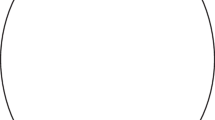Abstract
The generally accepted permeability theory of nerve conduction is presented in mathematical form. The resulting velocity formula is found to agree well with data on squid giant axon, but predicts velocities considerably too high in the case ofNitella. The dependence of velocity on fiber diameter is discussed for both medullated and non-medullated nerve, it being shown theoretically that velocity is proportional to the square root of diameter for non-medullated and to the diameter for medullated nerve. The equations relating the shape of the action spike to the observed permeability changes are given but are not solved.
Similar content being viewed by others
Literature
Bernstein, J. 1912.Elektrobiologie, p. 95. Braunschweig: Vieweg & Sohn.
Broemser, Ph. 1925. “Das Prinzip der Nervenleitung.”Zeit. F. Biol.,83, 355–398.
Carlson, A. J. and Johnson, V. 1937.The Machinery of the Body. Chicago: University of Chicago Press.
Cole, K. and Curtis, H. 1939. “Electric impedance of Nitella during activity,”J. Gen. Physiol.,22, 37–64.
Cole, K. and Curtis, H. 1938. “Electric impedance of squid giant axon during activity.”J. Gen. Physiol.,22, 649–670.
Cole, K. and Hodgkin, A. 1939. “Membrane and protoplasm resistance in the squid giant axon.”J. Gen. Physiol.,22, 671–687.
Cremer, M. 1923. “Die Ableitung der Cremerschen Formel für die Fortpflanzungsgeschwindigkeit der Erregung im Nerven.”Quart. J. Exp. Biol. Suppl., 96–97.
Cremer, M. 1909.Nagel's Handbuch der Physiologie des Menschen. p. 910. Braunschweig: Vieweg & Sohn.
Erlanger, J. and Gasser, H. 1937.Electrical Signs of Nervous Activity. Philadelphia: University of Pennsylvania Press.
Gelfan, S. and Gerard, R. W. 1930. “Studies of single muscle fibers.”Am. J. Psysiol.,95, 412–416.
Gerard, R. W. 1931. “Nerve Conduction in relation to nerve structure.”Quart. Rev. of Biol.,6, 59–83.
Gerard, R. W. 1930. “The response of nerve to oxygen lack.”Am. J. Physiol.,92, 498–541.
Gerard, R. W. 1932. “Nerve Metabolism.”Physiol. Rev.,12, 512.
Heilbrunn, L. W. 1938.An Outline of General Physiology. Philadelphia: Saunders.
Hermann, L. 1899. “Zur theorie der Erregungsleitung und der elektrischen Erregung.”Pflüg Arch.,75, 574–590.
Hodgkin, A. L. 1939. “The relation between conduction velocity and the electrical resistance outside a nerve fiber.”J. Physiol. 94, 560–570.
Hodgkin, A. L. 1938. “The subthreshold potentials in a crustacean nerve fiber.”Proc. Roy. Soc. B.,126, 87–121.
Hursch, J. B. 1939. “Conduction velocity and diameter of nerve fibers.”Am. J. Physiol.,127, 131–139.
Katz, B. 1937. “Experimental evidence for a non-conducted response of nerve to subthreshold stimulation.”Proc. Roy. Soc. B.,124, 244–276.
Katz, B. and Schmitt, O. H. 1940. “Electric interaction between two adjacent nerve fibers.”J. Physiol.,97, 471–488.
Lillie, R. S. 1923.Protoplasmic Action and Nervous Action. Chicago: University of Chicago Press.
Lillie, R. S. 1929. “Resemblance between the electromotor variations of rhythmically reacting living and non-living systems.”J. Gen. Physiol.,13, 1–11.
Offner, F. 1939. “Circuit theory of nervous conduction.”Am. J. Physiol.,126, 594.
Pumphrey, R. J. and Young, J. Z. 1938. “The Rates of Conduction of nerve fibers in cephalopods.”J. Exp. Biol.,12, 453–466.
Rashevsky, N. 1931. “On the theory of nervous conduction.”J. Gen. Physiol.,14, 517–528.
Rashevsky, N. 1933. “Some physico-mathematical aspects of nerve conduction.”Physics,4, 341–349.
Rashevsky, N. 1935. “Some physico-mathematical aspects of nerve conduction. II.”Physics,6, 308–314.
Rashevsky, N. 1938.Mathematical Biophysics: The University of Chicago Press.
Rushton, W. 1937. “Initiation of the propagated disturbance.”Proc. Roy Soc. B.,124, 210–243.
Tasaki, I. 1939. “The electro-saltatory transmission of the nerve impulse and the effect of narcosis upon the nerve fiber.”Am. J. Physiol.,127, 211–227.
Umrath, K. 1927. “Über die Erregungsleitung bei sensitiven Pflanzen.”Planta,5, 274–324.
Weinberg, A. 1939. “Nerve conduction with distributed capacitance.”J. Applied Physics,10, 128–134.
Weinberg, A. 1940. “The equivalence of the conduction theories of Rashevsky and Rushton.”Bull. Math. Biophys.,2, 61–64.
Author information
Authors and Affiliations
Rights and permissions
About this article
Cite this article
Offner, F., Weinberg, A. & Young, G. Nerve conduction theory: Some mathematical consequences of Bernstein's model. Bulletin of Mathematical Biophysics 2, 89–103 (1940). https://doi.org/10.1007/BF02478173
Issue Date:
DOI: https://doi.org/10.1007/BF02478173




